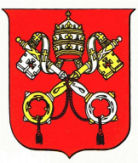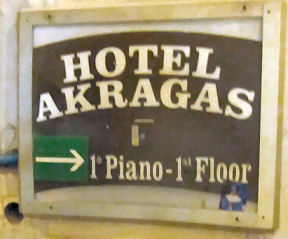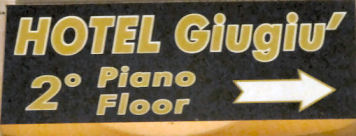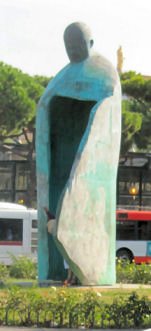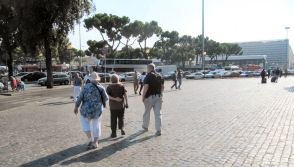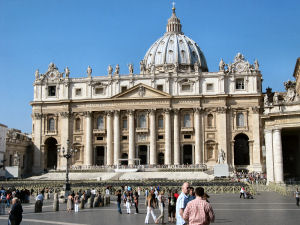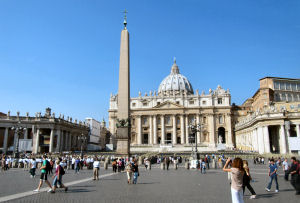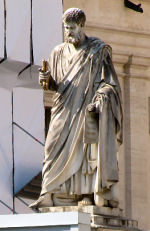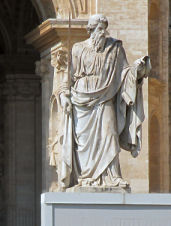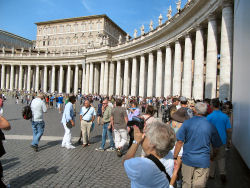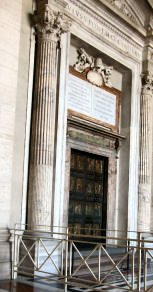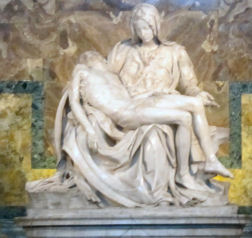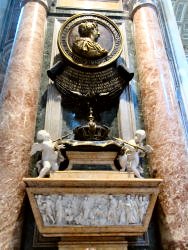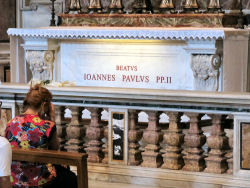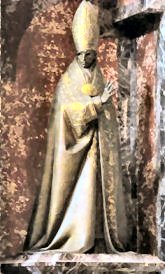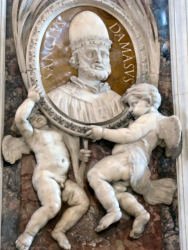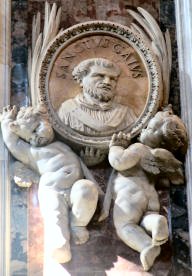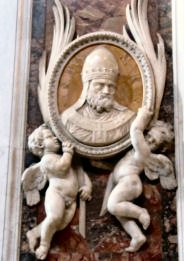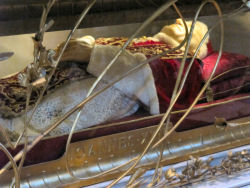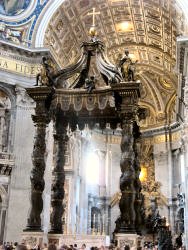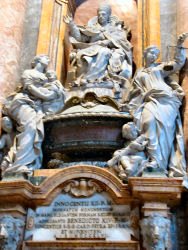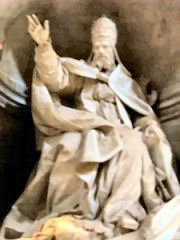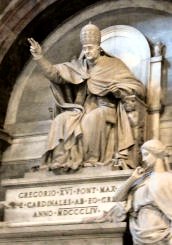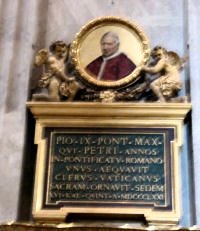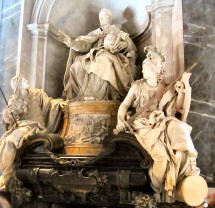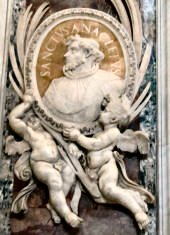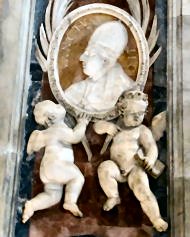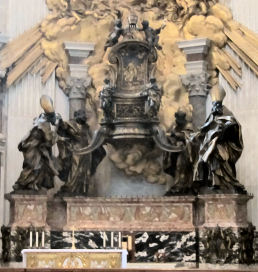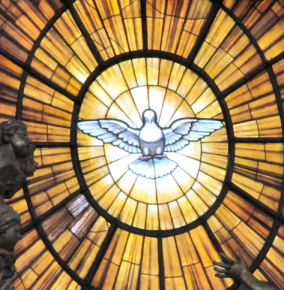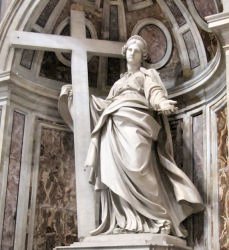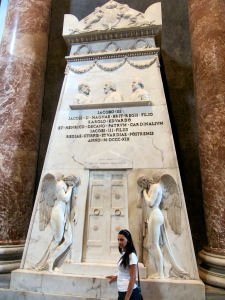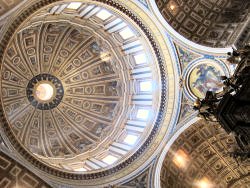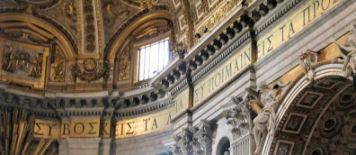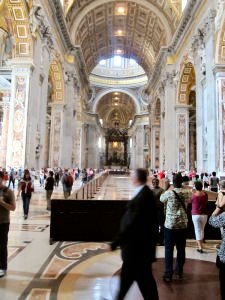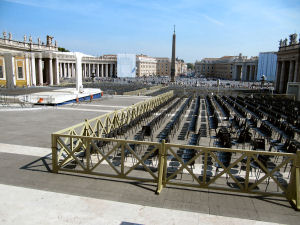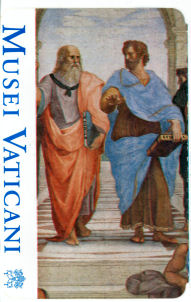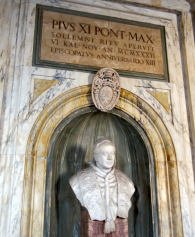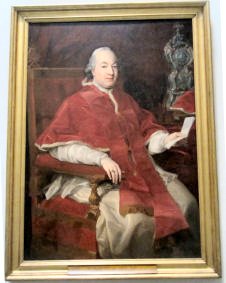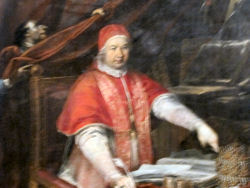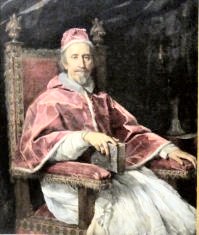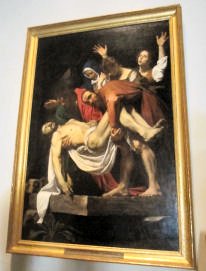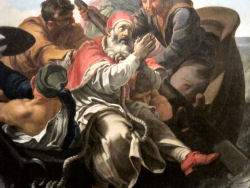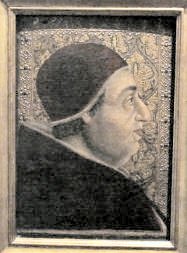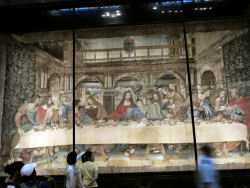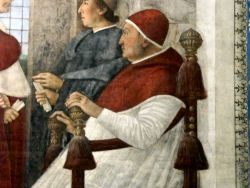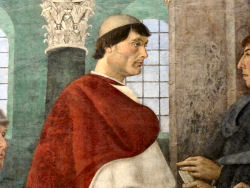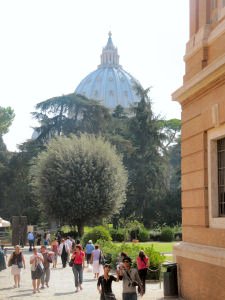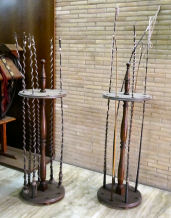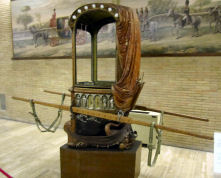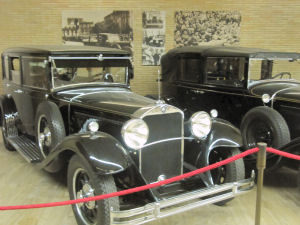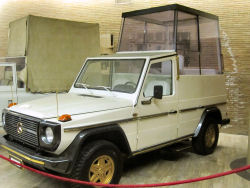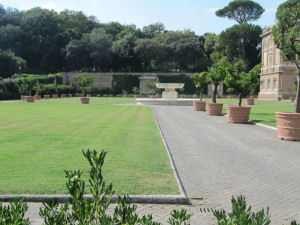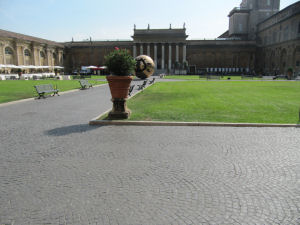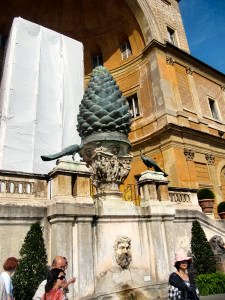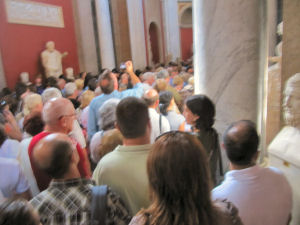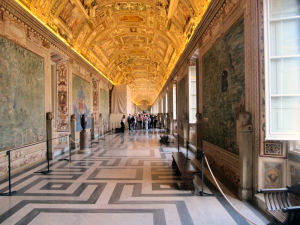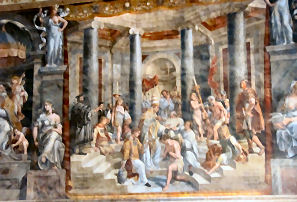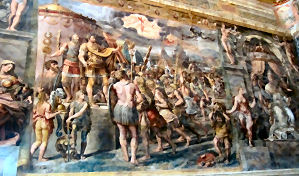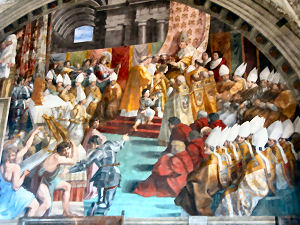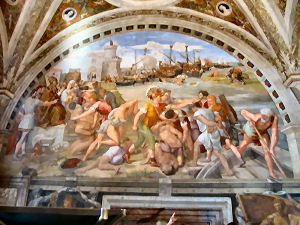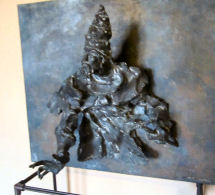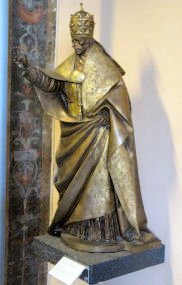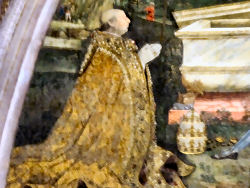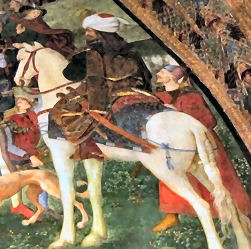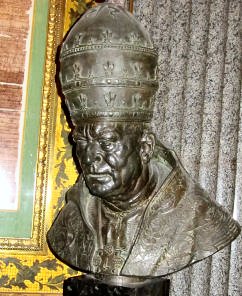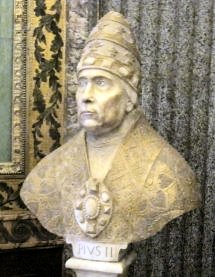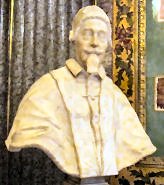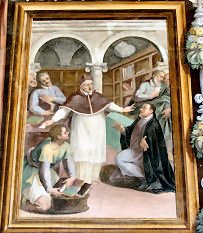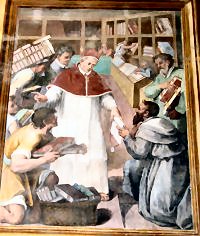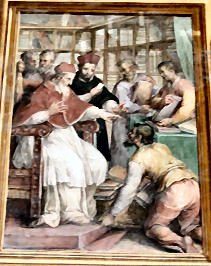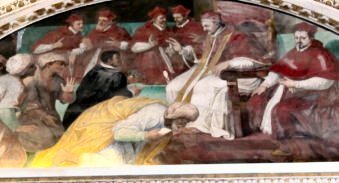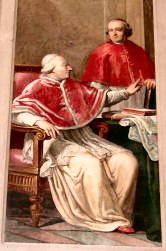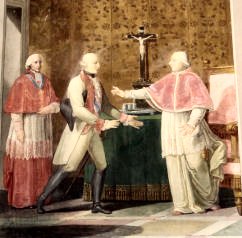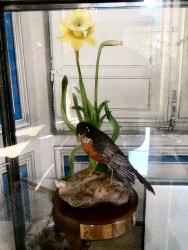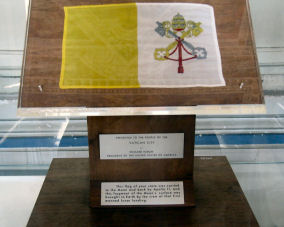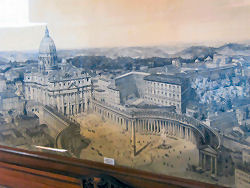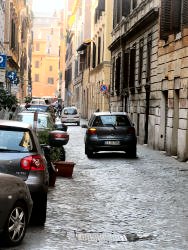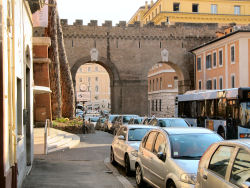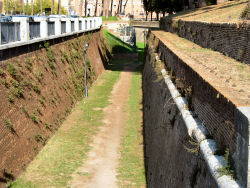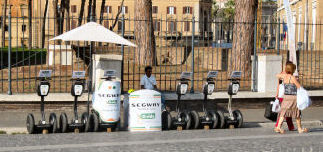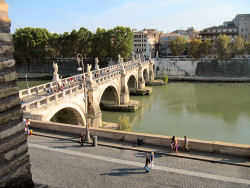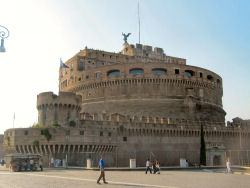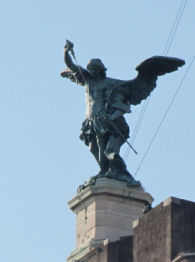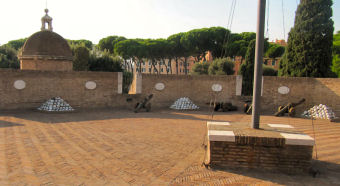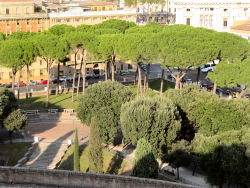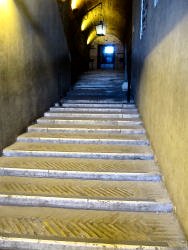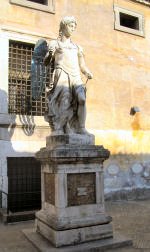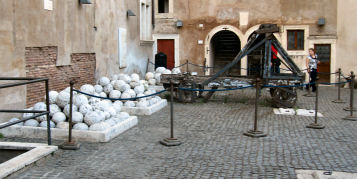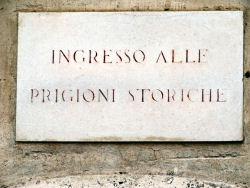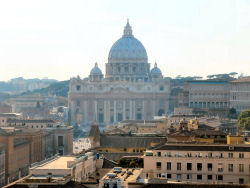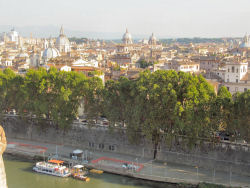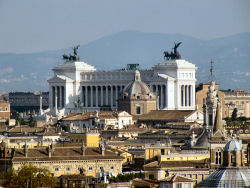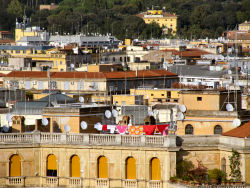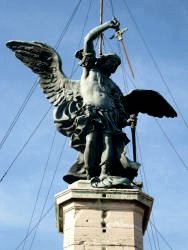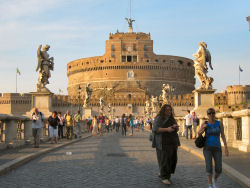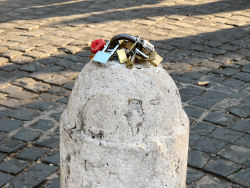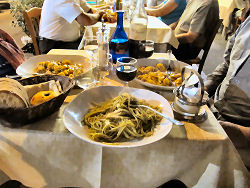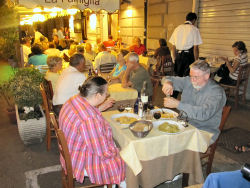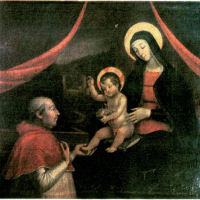I woke up at a little after seven and looked out the window. The weather appeared to be very nice again. The projected high was in the eighties. That was perfect for me, but Sue preferred it quite a bit cooler.
The elevator and staircase were shared by three hotels: The Akragas was on the first floor (that is, the one immediately above the ground floor); the Giugiú occupied the second; our hotel, the Selene, was on the third and fourth floors. The breakfast room for our hotel was located on the third floor. Sue had obtained the password for the Internet, and I managed to sign on to the web without difficulty, but my e-mail client did not work at all. I had never encountered this problem before; it appeared to me that port 110 might not be open. If I really needed to send an e-mail, I knew how to do it through the AT&T server. I could check the e-mail for my business account there, too, but it would be a nuisance. I could not think of any way of checking my other two e-mail accounts. I had really become quite dependent on my computer’s e-mail client.We met the Corcorans for breakfast at nine. It was the usual fare for a small European hotel. Many of the other diners in the breakfast room seemed to be part of a tour. We later learned that they were at the very end of a Best of Europe[1] tour. I wonder if their evaluations will complain about the toilet paper dispensers at the Hotel Selene.
Our plan for today was to tour St. Peter’s Basilica and the Vatican Museums. Sue and I had seen both of these in 2003, but I had a long list of things that I wanted to see again now that I was more knowledgeable about Church history. For some reason Sue experienced no great joy in repeated visits to incredibly ornate Catholic churches. So she would undoubtedly be going out on her own. Patti and Tom wanted to see St. Peter’s and the Vatican Museums. All four of us decided to start the day by going to St. Peter’s. After that we would play it by ear. I would take the Metro and walk from the Ottaviano Metro station. They would take the hop-on, hop-off bus using the tickets that they had purchased on Thursday, which were good for two days. We left the hotel at 10:30 and once again walked up to Piazza Cinquecento together. I bought my Metro tickets at the biglietteria near the entrance and took the A line toward Battistini. The Metro was crowded; I stood all the way.As I walked up Via Ottaviano toward the Vatican, I remembered the way pretty well from eight years ago. I was, however, surprised to see quite a few high-end stores. Who would go shopping there? Callista Gingrich?
I passed a branch of BNL, the Bank of America’s working partner in Italy. It occurred to me that I probably should get some more euros. There was no telling whether we would be able to find any BNL branches once we left Rome. I made up my mind to stop there when I had to retrace my steps to get to the Vatican Museums.
I was aghast when I finally reached Piazza San Pietro and went through the columns. Our plan of meeting on the steps would never work. Row upon row of seats had been roped off from the foot of the steps halfway to the obelisk. The line to get into the basilica formed on the right of these seats and stretched three-fourths of the way around the colonnade. I could hardly believe my eyes. When we came here in 2003 we just walked in.I was quite certain that my companions would not be here yet, but I looked for them in every location that I could think of. If I knew Sue (and it had been thirty-nine years at this point), she would be in the shade, and the only shade was under the roof between the rows of columns.
Some young men in white shirts were posing for a picture with the basilica in the background. They were holding a Texas flag. For some reason this irked me. I felt as if someone was trying to usurp my heritage a little.
I saw several groups led by tour guides enter the piazza, but the line to enter the basilica, which was actually moving at a slow walking pace, was getting shorter, not longer.
Sue, Patti, and Tom arrived at a little after 11:30. By then the line stretched less than halfway around the piazza. Tom and I trekked over to the end. Sue stayed with Patti for a few minutes at one of the fountains. When we got fairly close to the security checkpoint, Patti joined us in line, and Sue got back on the bus. The security was similar to what one expects at an airport – X rays, metal detectors, and alert guards. I placed everything from my pockets in a compartment of my backpack. Tom had a little trouble with something; he had to go through several times.I did not remember that we had to undergo such scrutiny in 2003. That was one and a half years after 9/11. Was the situation worse eight and a half years later? Was that not proof that the terrorists won? Or at least that our blustery reaction made things worse, not better?
Next we had to pass inspection by the modesty police. I had no worries; I was wearing my nylon warm-ups over my shorts. I was afraid that the lovely young lady in front of me who was wearing a short dress might have more difficulty, but they let her through with no trouble. Either they thought that her black stockings were modest enough or they were taken by her looks.[2] I noticed that she had a whitehead on the back of her right shoulder. I resisted the temptation to pop it even though it would only have taken a second.
Patti was moving very slowly. I stopped and waited for her several times. Tom suggested that I go on ahead. He would go at Patti’s pace. This had never had occurred on previous trips.[3]
Once I got inside the basilica I found that it was not crowded at all. The Church is absolutely enormous, so much so that I was completely oblivious of a mass that was being said in one of the chapels on the far left side.The mandatory first stop is to view the Pietà. I knew that it was surrounded by bullet-proof glass ever since that maniac tried to destroy it with a hammer in 1972. However, my recollection was that at the time of my last visit one could see all sides of the statue. In 2011 one could only view it from the front. This was patently absurd. Statues are by definition three-dimensional. I could certainly appreciate the concerns about the security, but if it was not possible to view the statue from all sides inside the basilica, I think that they should move it somewhere where it could be more easily guarded. Florence had found a way to protect the David in a fairly reasonable manner.
I next took a photo or two of the monument to Queen Christina of Sweden. I had totally missed this on the first trip. I found it remarkable that the popes saw fit to build a monument to a cross-dresser who had been born and raised as a Lutheran. Beyond a doubt she was completely unique and one of the most influential people in the history of the Church. Needless to say, the chapel dedicated to Pope John Paul II did not exist when we visited the basilica the first time. In 2011 I found it crowded with worshipers and admirers.I don’t think that many people realized that the corpse of Pope John XXIII was on display nearby. I know that I was surprised to learn this when I had read it on the Internet. Not many people were in that area of the basilica when I arrived. It was rather easy to take a photo. Catholics seem to be much more comfortable exposing the dead than other people. Many people have told me that this kind of thing creeps them out.
Bernini’s Baldacchino, which is suspended over the altar is incredibly gigantic. I had read that it was seven storeys tall! I looked for the Barberini bees on the columns, but I could not locate any. I had a fairly strong feeling that I had spotted them in 2003. Perhaps I was looking in the wrong place.
My memory from the previous visit was that the interior of the basilica was dominated by innumerable shrines and monuments to saints.[4] There were a few of those, but this time I was looking for depictions of the popes, and boy did I find them! Nearly every pope since the Renaissance times had seen fit to order the construction of a monument to himself or a predecessor. Some of them, such as the reactionary trio between Pope Pius VII and Pope Pius IX, are pretty much universally reviled, but they were well represented in the basilica.
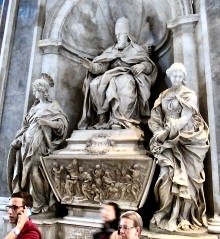 You would never guess it from his monument, but Pope Leo XI died after only twenty-six days as pontiff. |
I remembered being very disappointed in 2003 that we were not allowed to get very close to the apse. Maybe it was my imagination, but, although it was still roped off, it seemed that I was a little closer when I took photos of Bernini’s throne and the huge dove on the window.
I noticed a girl going to confession on the right side of the basilica. Every so often one needs to remind oneself that this was a real church, not just a self-constructed monument to the popes.
I was hoping to go to the crypts to see who beside the popes are buried here. However, the guidebook that I was using reported that one had to book in advance for the crypt, and I had not done so.
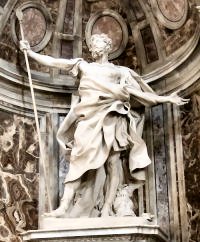 Legend says that Longinus, whose lance pierced Jesus on the cross, became a saint. The story of the lance is here. |
As I made my way to the left side of the basilica I was astonished to see that a mass was in process in one of the chapels there. I neither saw nor heard any indication of this until I got quite close.
I continued down the left side of the basilica photographing statues and monument. Eventually I got poped out and headed for the exit. I actually went out the door before I remembered reading about two equestrian statues in the atrium of Constantine and Charlemagne. When I went back in to look for them, I heard “Cap off!” from someone behind me. I hastily removed my Mystic Seaport baseball cap and jammed it into my pocket. I searched for the statues for a few minutes, but I could not find them. They were there; I just did a poor job of looking.[5]
When I exited the second time I was startled to find myself once again right behind the young lady with the short skirt and black stockings. Was it just coincidence or was the ghost of Pope Alexander VI telling me that it was time to make a move? While I pondered, she disappeared into the crowd.I saw neither Tom nor Patti inside the basilica. It would be a great place to stage a game of hide and seek.
I began the long walk to the Vatican Museums. It was pretty warm out, and I was getting a little hungry and thirsty. Nevertheless, I made the trek without seeking sustenance and was amazed to find no line at all. I used a credit card to by my admission ticket for €15 and walked in.
I was pretty certain that the only place in the Vatican Museums to obtain food and liquids was near the entrance. I also knew that once I began the long march to the Sistine Chapel, I was pretty much committed to finishing it. Actually, many of the things that I was most interested in were in the hallway used for the return trip.I had been unimpressed with the Vatican’s caffeteria eight years ago, and I was not about to eat in the restaurant by myself. From the signs I deduced that the museum now had a pizzeria as well. I decided to give it a try. What a mistake. The line was not very long, but it was incredibly slow. I could not understand the system at all. You ordered and paid at the cash register, but the lady who handed out the pizza did not pay any attention to the receipts.I ordered two slices of pizza. Both of them were worse than Sbarro pizza at an Interstate rest area. I thought for a moment that this must surely be the worst pizza in Italy, but then it occurred to me that the Vatican Museums were not technically in Italy. I wondered where they found someone to create this stuff, surely not among the citizens of Rome. Italians cut corners in some areas, but no one would tolerate this.
I also ordered a Pepsi Light,[6] and a bottle of water. I specifically ordered the Pepsi Light because I saw it in a soda dispenser, but the guy at the counter ignored this possibility and withdrew a lukewarm bottle for me from a nearby case. I was able to give him exact change €10.70. They sold beer at the Vatican, and I probably should have gotten one. There was at least a small chance that it might have been cold. After I finished lunch I decided to explore the nearby areas. There are quite a few very nice courtyards near the entrance to the Vatican. I do not know why, but they were not very crowded. I lingered in them a while and took some photos.I started my serious touristing with the Pinacoteca, i.e., the art gallery. Sue and I had spent quite a bit of time in these rooms eight years ago, and I had little desire to devote as much time as we did then. I still had quite a bit on my agenda. However, I definitely did want to view the Carvaggio again.
I was a little surprised to see quite a few portraits of popes and a few other characters whom I had encountered in my researches. I took photos because some of them might serve as illustrations for my book. Most of the paintings were familiar to me, but they certainly made no impression on me on my first visit, and I sincerely doubt that anyone except died-in-the-wool popeaholics such as myself paid them much attention. I found the Caravaggio painting, which is commonly know as The Deposition or The Entombment of Christ. I could not say that it was one of my favorites. The woman in the back with her arms raised kind of ruined it for me. I did admire the knobby knees of the barefooted guy wearing the red outfit who was holding Jesus, whose own undoubtedly knobby knees were disappointingly hidden from view.Nearby was a painting of St. Peter’s crucifixion by Guido Reni. It was fairly impressive, but more than anything it reminded me that I definitely wanted to return to Santa Maria del Popolo at some point to see Caravaggio’s treatment of the same subject. It blew me away in 2003, and at the time I had virtually no appreciation of art.
I searched through a few rooms for the unfinished Leonardo, but I could not find it. I should have been a little more thorough in my research before coming to the Vatican. I remembered that the last time that I came here the room that it was in was closed off for a few minutes, and I needed to return a second time in order to see it.
Few people knew about the carriage museum that was tucked away in the basement of the Vatican Museums. It was not easy to find, but after a few wrong turns I located it. I had enjoyed looking at all of the carriages that we saw in the Armory in Moscow. I wondered how the Vatican’s collection measured up. The answer was, in one word, “poorly.” Almost all of the carriages on display belonged to only one pope, Pius IX. Perhaps I should have anticipated something like this. There was a long Roman tradition of looting each pope’s residence right after his death. Who knows how many papal carriages were destroyed or stolen in the process? I have never read about a protocol for handing down property from one pope to the next. Most popes probably reckoned that items like the livery and carriages from their predecessor belonged to that pope’s family, not the papacy. Most pontificates just started with a blank slate. Even so, it seemed that there would be more than a handful of drab looking carriages on display. The curators carefully displayed the harnesses worn by the pope’s horses on hobby horses. Since each horse was dressed identically, this did little but use up space.
There was one small sedan chair that presumably protected the pope’s slipper-clad feet from contact with Mother Earth, but there was not a single sedia gestitoria, the monstrous contraption in which the popes were carried around up until the 1960’s. I would definitely liked to have seen one of those.
In the very rear of the room was a small collection of popemobiles. For years the pope motored around in a black limousine like any other VIP. Only in recent decades was the pontiff provided with a vehicle in which he could stand inside a bulletproof compartment. The one on display was an old one. Whenever the pope visits a foreign country, the host country is expected to provide him with a suitable vehicle. So, there is, sad to say, no official popemobile.I was very disappointed with the carriage museum. I suppose that I should have realized that if the Vatican had anything interesting to display of this nature, they would not hide it down in a basement that was so difficult to reach.
It was time to begin the arduous trek to the other end of the Vatican Museums. Touring these museums has always been an endurance contest. Between the museums that house the ancient sculptures and artifacts, which I ignored on this visit, and the Sistine Chapel was a long set of connected buildings that are two stories tall. They contained the incredible Vatican Library, but special permission is required to visit it. The areas that are open hosted one-way traffic headed to the grand prize of the Sistine Chapel. It is safe to say that virtually everyone who visited the Vatican Museums went to the Sistine Chapel.
I had made it to the Sistine Chapel twice in 2003, and Sue and I spent quite a bit of time there. It had a profound effect on me, but I had little desire to return. I went there this time because I could not figure out any other way to get to the long return hallway that some people have called “the pope’s attic.”
I should have started this journey earlier. I encountered a truly incredible number of tourists. A cruise ship or two must have unloaded them while I was choking down my pizza or wasting time in the Carriage Museum.The worst bottleneck was in the entry to the Rotunda Room. I had not the slightest interest in doing anything here except getting through the crowd. Fortunately, I was blessed with extremely sharp elbows, and I was able to squeeze through a wall of human flesh and enter a corridor that was slightly less crowded. This was, without a doubt, one of the most unpleasant experiences of my life.
I finally made my way past the bulk of the crowd in the gallery that was so long that it contained not one, but two souvenir stores. The last barrier to the Sistine Chapel were two sets of rooms, the Raphael Rooms and the Borgia Apartments. The former were decorated by Raphael and his followers. The latter were originally decorated by Pinturicchio, but they were in much worse condition, and almost no one visiting the Vatican Museums cared much about them. My interests, on the other hand, were drawn more to the mysterious Borgia Apartments than to Raphael’s flamboyant fantasies. I had read that some of the frescoes there depicted real people whose lives greatly intrigued me. Specifically I wanted to see Giulia Farnese, Pope Alexander VI’s last mistress, who was widely reputed to be the most beautiful woman in Italy, and Djem, the son of one Turkish sultan and the brother of another. Djem was the central character in what must have surely ranked as the most bizarre tale in the entire history of the papacy, or at least since the much more notorious Cadaver Synod in the eighth century. Sue and I had spent quite a bit of time in the Raphael rooms in 2003. I was already as appreciative of them as a geek like me can be. This time I was more interested in the historical aspect of his works.The last time that I visited the Constantine room I was unaware of the fact that the depictions on the walls were entirely fictitious. The huge painting of Constantine at the Milvian bridge comes fairly close, at least for Raphael, at depicting Constantine’s vision of a cross. However, other versions report that he saw the chi-rho symbol or just an array of stars. Whether he saw or heard “In this sign you will conquer” is disputed, but if he did, it was in Greek, not Latin.
The other famous paintings are complete fabrications. The depiction of Pope Sylvester I baptizing Constantine grotesquely distorted the historical facts. Contemporary accounts leave little or no doubt that the emperor was baptized on his deathbed by a bishop named Eusebius of Nicomedia, who famously espoused the Arian heresy. The Donation of Constantine is even worse. It depicts the emperor giving Italy and most of Europe to the pope when he decided to move his headquarters to Constantinople. This is based on a group of documents that were forged at some point in the eighth century. They were used by the popes for many centuries to buttress their claim to be the legitimate ruler of the Papal States.[7] However, at the time that this painting was made, it was already common knowledge that they were forgeries.I have long considered the fresco of the encounter between Pope Leo I and Attila the Hun to be even more disturbing. In Raphael’s version the meeting took place at the gates of Rome and was attended by a complement of prayerful bishops. St. Peter and St. Paul appeared in the sky with their swords, and Attila was so scared that he ran away. All historical sources, however, report that the meeting took place well to the north of Rome. A few senators may have accompanied Pope Leo, but the negotiating party was quite small.
No one is certain how Pope Leo persuaded Attila to leave Italy. It certainly was one of the greatest diplomatic achievements[8] of all time. I considered it an insult to one of the greatest popes to drag St. Peter and St. Paul into the picture.I stopped for a moment to admire the gigantic twin frescoes, The School of Athens and La Disputa. I spent quite a bit of time here eight years ago. In 2011, however, I had smaller fish to fry. On to the Borgia apartments.
I had read that the Borgia apartments were used to house a collection of modern religious art. I could hardly imagine anything that would interest me less. However, I did managed to find a couple of stylized sculptures of popes, and I took photos of them.
It occurred to me that one of the best jobs in the world would be to guard one of these rooms. They were not crowded at all, and few people hesitated for even a moment as they went through. They could doubtless sense that the Sistine Chapel was just around the corner.What I really wanted to see were Pinturicchio’s frescoes. I had no trouble locating the one that showed Pope Alexander in a kneeling position. I wondered if the people who hung around in this room at the end of the fifteenth century laughed when they looked at it. The second Borgia pope did not exactly have a reputation for being devout.
I found a couple of depictions of the Madonna. My recollection was that Giulia Farnese had posed for one of these, but I was not certain which one.[9]
The painting that provided my primary motivation, however, The Disputation of St. Catherine, escaped my notice. I went back through each of the Borgia Apartments, but I could not find it. It was possible that they had closed off the Room of the Saints. It was also possible that my legendary inability to find things was responsible. It was then that I noticed a woman inspecting a dark side of one of the rooms that was nearly devoid of religious art. I could not tell what she was looking at, but it appeared that the wall there was painted, but only from about ten feet up. I walked over and discovered the treasure. I knew only two things about The Disputation of St. Catherine. The first was that the Catherine in the picture was not the familiar St. Catherine of Siena. It was some other St. Catherine. I did not know what she was disputating about, and I doubted that anyone else did. What I did know was that Djem himself had posed for the portrait as the guy on the white horse. I took some very careful photos. It was not easy with my trembling hands in the very poor light. From there I joined the dense crowd pressing to enter the Sistine Chapel. I did not stop to look at it all. I realized that this placed me in the camp of the Philistines, but I had visited this beautiful room twice in 2003, and Sue and I had spent quite a bit of time inhaling the air permeated by the masterpieces. One thing was a major disappointment this time; not once did I hear the voice of the Almighty come over the holy loudspeaker saying “Silenzio!” Instead, an occasional “Shhhhh!” would come from one of the many priests milling throughout the room. It was virtually impossible to think of this most ornate of halls as a church, and it was difficult to imagine that any of the three Persons of the Trinity would be offended by the comments of the onlookers.The Sistine Chapel, by the way, is named after the man who ordered its construction, Pope Sixtus IV, who was implicated in the murder and attempted murder of the Medici brothers in the fifteenth century. The pope’s nephew, Julian della Rovere, eventually became Pope Julius II, the man who cajoled Michelangelo Buonarotti into painting the ceiling.
The return trip from the Sistine Chapel to the entrance was undoubtedly tedious for most people, but it was what I came for. Whereas I was certainly the fastest walker on the journey to the Sistine Chapel, almost everyone passed me on the return trip. My recollection was that the long corridors were peppered with all kinds of knickknacks pertaining to popes of the previous five or six centuries. I seemed to recall a lot of engraved silver and gold items. There was some of that in 2011, but what I mostly encountered this time were paintings of a few popes and three massive rooms that told in almost cartoon-like fashion the stories of three popes.Pope Paul V, the Carafa pope, was a notorious hard-liner whose papacy began in 1555. He had nourished an undying hatred of the Spanish during his many years in Naples, which in those days was ruled by Spain. He was famous for creating the Index, the list of banned books that survived until well into the twentieth century. To my way of thinking he was one of the least admirable popes. I found it hard to believe that the Vatican paid tribute to him.
Pius VI was pontiff during the last quarter of the eighteenth century. He was considered by most Italians to be a grandstanding mountebank who accomplished little other than to make his family prosperous. However, he earned respect during the last few years of his pontificate when he was taken prisoner by Napoleon and died in exile. His successor, Pius VII, was repeatedly duped by Napoleon. He went to France of his own free will to crown Bonaparte as emperor,[10] but he ended up being held more or less against his will in France for several years. The situation was so bad that speculation was rampant that the papacy was finished as an institution. However, when Napoleon was captured, the pontiff returned to Rome and established a degree of normalcy. There was one last item that I hoped to locate. I remembered it distinctly from my first visit. I had never seen a single reference to it in print or on the Internet. If I located it and got a photo of it, my visit would be considered a great success.
There it was. I could hardly contain my glee. In a container of glass or clear plastic stood a life-sized statue of a robin and a yellow flower. I did not remember the flower, but the bird was etched in my memory as a token of the heartfelt esteem that Richard Nixon felt for Pope Paul VI. Was it paint-by-number? I could not really tell, but it certainly bore no resemblance to the works of Raphael or Michelangelo. I knew in my heart that the real intent of our nation’s president’s was to give the bird to the pope.
Next to it was a very small Vatican flag and a piece of paper that said that it had made the trip to the moon and back. Amidst all the splendid items in this incredible museum this exhibit stood out as undeniably the cheesiest gift that any head of state ever made to the Vicar of Christ. It made me so proud to be an American. I stopped for a minute in the bookstore. I could have used another short-sleeved shirt on this tour. I wanted to a buy a black tee shirt that was featured in the bookstore. It had only two fingers on it – Adam’s and God’s – and no words. Unfortunately the only size that they had for it was S, and not even I am that skinny.Exiting the Vatican Museums required descending a long spiral staircase. The stairs were very uneven. There was a railing, but I had to wonder how many people fell down here every year, and if the esthetics of the effect justified the cost.
I was pretty tired from walking around the museum. I stopped and took a swig from the water bottle that I had purchased in the pizzeria. I retrieved my map from my backpack and plotted a course for my final destination of the day, Castel Sant'Angelo. Sue and I had somehow neglected to visit it at all on our first trip to Rome. I wondered for a moment if the museum would lend me the pope’s sedan chair, but even if they did, they probably would not supply the bearers. So, I set off on foot. I located the BNL branch on Via Ottaviano and withdrew another €250. We would need quite a bit of cash tomorrow to pay the driver that we had hired to take us to the Alban Hills.The walk down Borgo Vittorio was both pleasant and surprising. Less than a block from the Vatican life changed dramatically. It was a one-way street that was virtually empty. I could see craftsmen at work in one of the windows. There was even a tire store, a tire store in the middle of Rome!
This must have been the part of the city that caught fire during the reign of Pope Leo IV. He was famous for the answered prayers that he made in response to the conflagration. He prayed not that the flames be extinguished but that they be turned away from the Vatican. They were, too, at least according to legend and Raphael.I felt a pain on my nose near my eye. I discovered that one of the little plastic feet on my prescription sunglasses had broken off. This was bad. I needed to get it fixed before we left Rome. Sunny weather was predicted for the next week or so, and the glasses were too annoying to wear as they were.
A few minutes of walking brought me to the moat around Castel Sant' Angelo. I stopped to rest, drink some more water, and orient myself. I determined from perusal of one of my guidebooks that the entrance was precisely on the opposite side of the spacious grounds. While I was at it, I plotted how to return to the Metro. I determined that the Lepanto Metro station, which I had never used, was closer than Ottaviano. It was not, however, close. I would probably be dragging on that last walk. I walked around the moat, past someone who was renting Segways to no one, and got my first good view of the Tiber River. It was not very impressive – low, brown, and virtually motionless. People were visible down on the embankment. As I gazed at the placid stream, the clever plan of the Medicis came to mind. They sold the assignment of guarding parts of the banks of the river to the rich and famous, and they made a lot of money doing so. Those were the days of the really creative popes.Entrance to Castel Sant'Angelo set me back €8. I really did not know where I was going. The Michelin guidebook recommended the Bagno di Clemente VII and the prisons. I looked all over for the former, but I could not locate it. The prisons were definitely closed off. I was not too disappointed. The best part of Castel Sant'Angel is the stunning view of Rome that is available from the top. This must have been the same view that Pope Clement VII had in 1527. I wonder if the weather was as good and the sky as clear then as he watched in horror as his loyal troops failed to execute the “lethal four-card fist” in the manner in which they had been trained. From this vantage point the pope probably had the best view possible of the Lutherans sacking his holy city. I climbed back down and undertook the long walk to the Lepanto Metro station. It looked like a straight shot on the map, but, in fact crossing the street was pretty difficult in a few places. Crossing a Roman street is an art form. One finds a cross walk. One steps in the street without looking directly at any cars. Good peripheral vision is a necessity. If the first car stops, one proceeds apace oblivious of other traffic. If not, as the Italians say, “Boh.”
I took the A line in the direction of Ananigna. I walked down to the hotel and took the elevator up to the room. Sue was in the room. I proposed that we walk over to the La Famigla, a family-run restaurant just beyond Termini, for supper. We had enjoyed eating there a couple of times eight years ago. We found it to have reasonable prices, outstanding selection, pretty good food, and a nice atmosphere.
Patti was resting again, so Tom and Sue and I hiked over to the restaurant. It was perhaps six or seven blocks. We would have had no problems finding the restaurant on our own, but a young man who was handing out literature about La Famiglia on Via Volturno insisted on escorting us. I assume that the restaurant paid him by the customer.
Tom reported that he and Patti never made it to the Vatican Museums. After their visit to the basilica they took bus #110 to Termini. Sue went to Villa Borghese and had a good time in the park there. They have tandem bikes for rent there, and she tried to persuade Tom that he should take Patti there and pedal her around. I guess that she meant on the upcoming Sunday.
The head waiter at La Famiglia seated us outside. To do so he had to bring a table out from the dining room. The weather was perfect, probably one of the last days of the year in which they would be able to accommodate so many people outdoors.I ordered the pesto, which was just fair, and the Roman lamb specialty, abbacchio. Sue had ossobuco. Tom was disappointed that he could not find sausage on the menu, but he really enjoyed his pork chops. The three of us shared a bottle of the house red wine.
I think that all three of us had a great time. Several times some street musicians came by to serenade us willy-nilly. One pair was a miniature Mariachi band! Men also came by selling flowers. None of these people got much of a response from any of the diners, and the head waiter watched them closely to make sure that they did not pester the diners.
The low point of the evening was when one of the Spanish-speaking guys at the adjoining table lit up a cigar after dinner. We took that as our cue to leave.
I told the head water that we had eaten here eight years ago. Sue was certain that she remembered him, but he said that he had only worked at La Famiglia for six years. He said that only the owner, the cook, and the formidable blonde lady who was ordering people around inside the restaurant were still there.On our walk back to the hotel we were astounded to see homeless people cooking their dinner on the pavement of the Piazza del Cinquecento in front of Termini. I definitely had noticed more beggars in Rome than I remembered from eight years earlier.
When we got back to the hotel, I sought out the advice of the lady at reception about my sunglasses, the possibility of purchasing a mouse, and my inability to send or receive e-mail. She advised me to try the mall that she said was under Termini for the first two. She also said that someone would come to the room to help me with the e-mail problem. No one ever did.
I went back up to the room, took a shower, and went to bed. The blister on my toe was no worse, and it was not a bit painful. I got to sleep in no more than a minute.
[1] Affectionately known as the Bussed of Europe tour.
[2] Yes, I know that I am old, but I am not dead yet.
[3] The Corcorans had joined us on the 2005 Village Italy tour, the 2007 Eastern Eurpope tour, the 2009 tour of Paris and the South of France, and a Russian river cruise in 2010.
[4] Since the eleventh century only three popes – Celestine V, Pius V, and Pius X – are considered saints.
[5] My inability to find things that were in plain sight had plagued me all my life. I almost flunked first grade because I could not find cardboard letters in a box. Fortunately my family moved, and the new school taught reading and writing without resorting to scavenger hunts.
[6] Coke was commonplace, if expensive, in Italy. The only place that I saw Pepsi was in the Vatican. I read once that Democratic administrations have promoted Coke, while Republican administrations have promoted Pepsi. I drink what is on sale.
